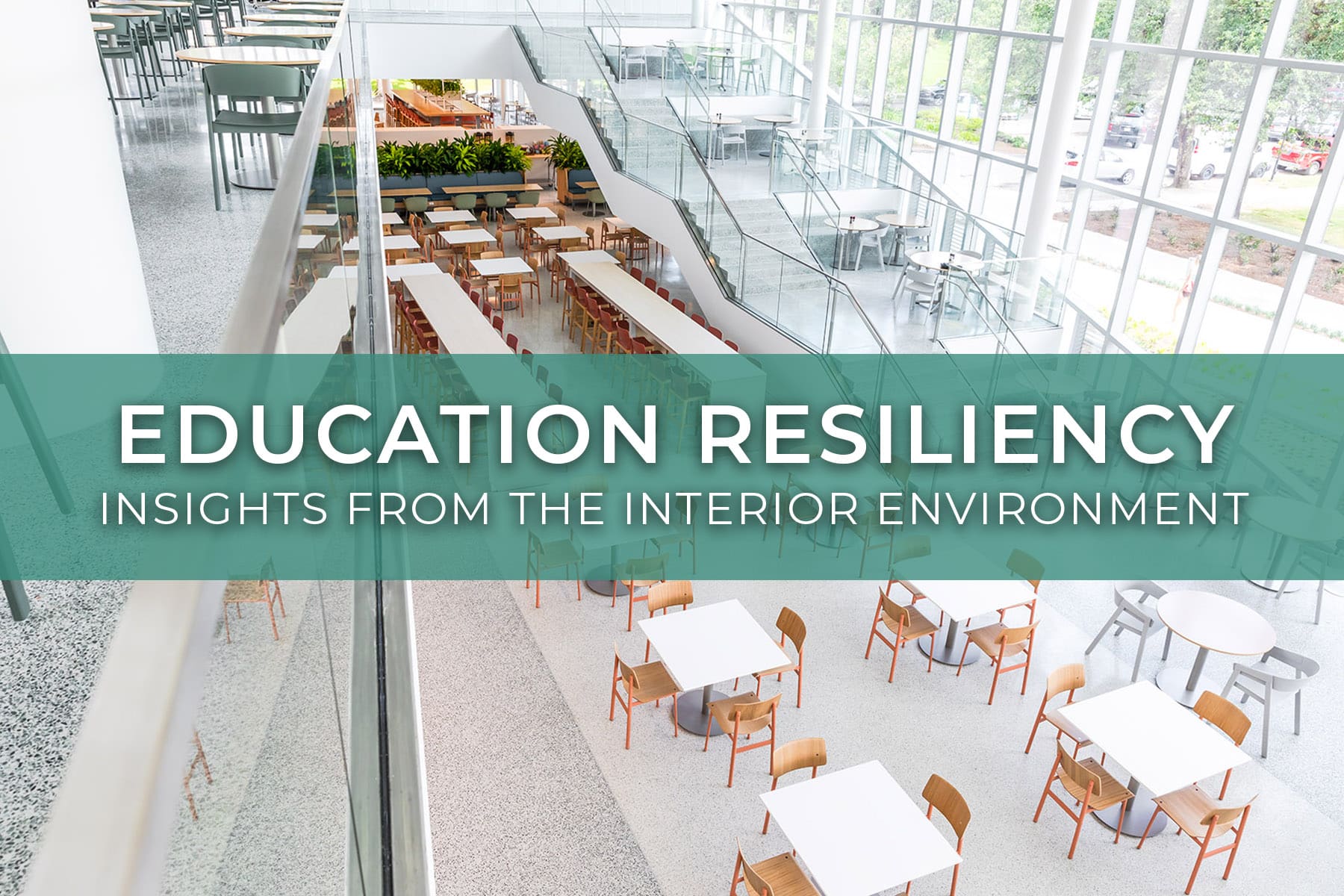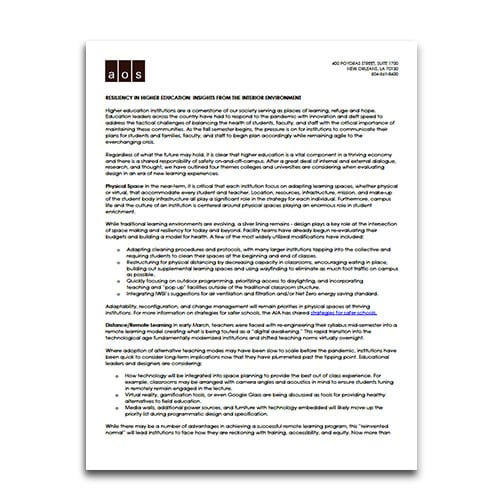
09 Sep Education Resiliency: Insights from the Interior Environment
Higher education institutions are a cornerstone of our society serving as places of learning, refuge and hope. Education leaders across the country have had to respond to the pandemic with innovation and deft speed to address the tactical challenges of balancing the health of students, faculty, and staff with the critical importance of maintaining these communities. As the fall semester begins, the pressure is on for institutions to communicate their plans for students and families, faculty, and staff to begin plan accordingly while remaining agile to the ever-changing crisis.
Regardless of what the future may hold, it is clear that higher education is a vital component in a thriving economy and there is a shared responsibility of safety on-and-off-campus. After a great deal of internal and external dialogue, research, and thought, we have outlined four themes colleges and universities are considering when evaluating design in an era of new learning experiences.
Physical Space In the near-term, it is critical that each institution focus on adapting learning spaces, whether physical or virtual, that accommodate every student and teacher. Location, resources, infrastructure, mission, and make-up of the student body infrastructure all play a significant role in the strategy for each individual. Furthermore, campus life and the culture of an institution is centered around physical spaces playing an enormous role in student enrichment.
While traditional learning environments are evolving, a silver lining remains – design plays a key role at the intersection of space making and resiliency for today and beyond. Facility teams have already begun re-evaluating their budgets and building a model for health. A few of the most widely utilized modifications have included:
- Adapting cleaning procedures and protocols, with many larger institutions tapping into the collective and requiring students to clean their spaces at the beginning and end of classes.
- Restructuring for physical distancing by decreasing capacity in classrooms, encouraging eating in place, building out supplemental learning spaces and using wayfinding to eliminate as much foot traffic on campus as possible.
- Quickly focusing on outdoor programming, prioritizing access to daylighting, and incorporating teaching and “pop up” facilities outside of the traditional classroom structure.
- Integrating IWBI’s suggestions for air ventilation and filtration and/or Net Zero energy saving standard.
Adaptability, reconfiguration, and change management will remain priorities in physical spaces at thriving institutions. For more information on strategies for safer schools, the AIA has shared strategies for safer schools.
Distance/Remote Learning In early March, teachers were faced with re-engineering their syllabus mid-semester into a remote learning model creating what is being touted as a “digital awakening.” This rapid transition into the technological age fundamentally modernized institutions and shifted teaching norms virtually overnight.
Where adoption of alternative teaching modes may have been slow to scale before the pandemic, institutions have been quick to consider long-term implications now that they have plummeted past the tipping point. Educational leaders and designers are considering:
- How technology will be integrated into space planning to provide the best out of class experience. For example, classrooms may be arranged with camera angles and acoustics in mind to ensure students tuning in remotely remain engaged in the lecture.
- Virtual reality, gamification tools, or even Google Glass are being discussed as tools for providing healthy alternatives to field education.
- Media walls, additional power sources, and furniture with technology embedded will likely move up the priority list during programmatic design and specification.
While there may be a number of advantages in achieving a successful remote learning program, this “reinvented normal” will lead institutions to face how they are reckoning with training, accessibility, and equity. Now more than ever, schools need to find new ways to address the needs of every learner. This demand for more engaged learning will accelerate new digital platforms, better equipping students to craft their own learning future.
Sustainable Business Models Historically, economic downturns have led to an influx in student enrollment in community colleges and in the wake of COVID-19 student trajectories may naturally shift closer to home. This trend may be a market advantage for states, like Louisiana, with a high number of institutions per capita. Regardless of the locale, competition between universities will likely be at an all-time high.
Forbes comments, “higher education entered the pandemic with pre-existing conditions: rapidly escalating costs, a widening disconnect with future workforce needs, crushing student debts, unacceptable racial disparities in outcomes, and low completion rates overall.” Budgeting and prioritizing these changes in terms of recruitment, fundraising, and quality of education will be a balancing act in pivoting toward thriving business models.
Many institutions are leaning into the connections that can be made beyond the campus, tapping into unique partnerships with local businesses, government and philanthropists. As we consider the role of education as an engine of our communities and cities, public and private sectors have an opportunity to build new synergies to help our students, and the communities they live in, thrive.
Value of Experience Only a fraction of the college experience occurs in the classroom. Experienced-focused education has long been touted as the key to developing critical thinking skills, clarifying values and developing an individual’s capacity to contribute to their communities. While some curriculum and learning styles transitioned to virtual seamlessly, hands-on learning, soft skills and connection to classmates have all suffered from afar.
Many institutions saw the pandemic actually elevate the importance of human interaction and further underscoring place and community as a core value proposition. Ultimately, we will not only need to rethink the physical components of an experience but the mental and social factors that create a thriving, evolved, and connected campus. Just as learning environments will employ hybrid solutions, student life, dining, housing, and recreation will all follow suit as they seek to engender culture and community.
Predicting the future may be arguably futile, but as designers we can aim to shape a positive path forward. This moment presents an opportunity to advance the potential in higher education, enhance the holistic experience, and cultivate the minds that will ultimately shape our post-pandemic world.
Click here to download a printable version of the white paper.

Want to learn more?
Check out these additional resources and thought-starters discussing what’s next for the education industry:
AIA Reopening America: Strategies for Safer Schools
Knoll Limitless Learning: The Post-Pandemic Campus Is Connected, Flexible, Resilient
DIRTT A New Wave of Higher Ed Spaces to Support Today’s Students
WELL Institute Keeping COVID Out of the Classroom
Architectural Record Firms Develop Strategies for Adapting K-12 Schools to the Pandemic
Building Design + Construction A Hybrid Learning Approach Could Redefine Higher Education
ArchDaily Poorly Designed Acoustics in Schools Affect Learning Efficiency and Well-Being

No Comments